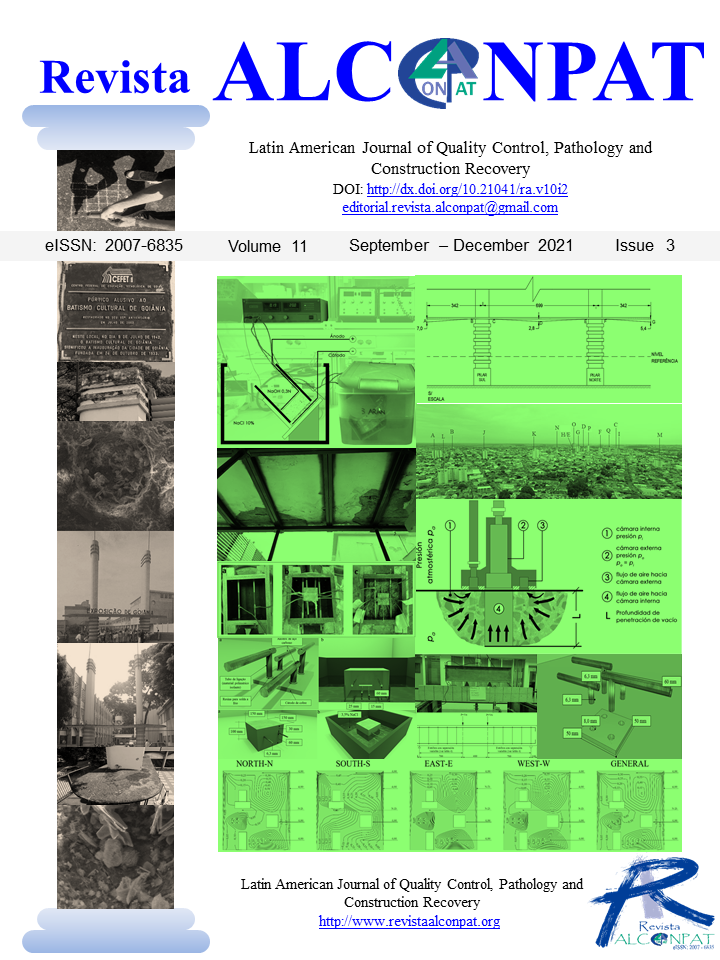Evaluation of the effect of waste clay from a polyol production process as a partial substitute for cement in reinforced concrete
DOI:
https://doi.org/10.21041/ra.v11i3.552Keywords:
corrosion in reinforced concrete, cement replacement, polyolica clay, durabilityAbstract
In this work, the effect of waste clay from a polyol production process was evaluated, as a partial substitute for cement in reinforced concrete, in concentrations of 0%, 5% and 10%. The physico-mechanical characteristics of the concrete and the electrochemical properties of the steel were determined during a period of 356 days (ISO 11474), in 15x10x5 cm specimens, with two steel bars embedded in the concrete. The results indicate that the compressive strength decreased proportionally according to the clay content; increasing for 90 days of curing. However, the capillary sorption of the concrete decreased, which allowed the steel in the marine environment to maintain its passive state for longer than its blank specimen, for the w/c ratios evaluated (0.45 and 0.60).
Downloads
References
American Concrete Institute, always advancing (2002), ACI 211.1-91: Standard Practice for Selecting Proportions for Normal, Heavyweight, and Mass Concrete (Reapproved 2009).
ASTM International (2018), C311/C311M-18 Standard test methods for sampling and testing fly ash or natural pozzolans for use in Portland-cement concrete. Retrieved from https://doi.org/10.1520/C0311_C0311M-18.
ASTM International (1989), ASTM C 618-89. Standard specification for fly ash and raw or calcined natural pozzolan for use as a mineral admixture in Portland cement concrete. Section 4, Volume 4.01, 1989, Pp. 296-298. Retrieved from https://doi.org/10.1520/C0618-19
ASTM International (2012), C39/C39M-12a Standard Test Method for Compressive Strength of Cylindrical Concrete Specimens. Retrieved from https://doi.org/10.1520/C0039_C0039M-12A
ASTM International (1999), D512-89(1999) Standard test methods for chloride ion in water. Retrieved from https://doi.org/10.1520/D0512-89R99
ASTM International (2007), E70-07 Standard test method for pH of aqueous solutions with the glass electrode. Retrieved from https://doi.org/10.1520/E0070-07
Calleja, J. (1983). Adiciones y cementos con adiciones. Materiales de construcción. (CSIC), Vol 33, Issue 190-191. Madrid: 25-52.
Devi, S., Gandhi, N., Jat, M., Marmat, N., Manda, B., Vaishnav, M. (2016). Utilization of marble and granite waste as partial replacement of cement in concrete. SSRG International Journal of Civil Engineering (SSRG-IJCE). 3 (5): 193-197. ISSN: 2348-8352.
Fagerlund, G. (1982). “On the Capillarity of Concrete”. Nordic Concrete Research, No. 1, Oslo, Ppe No. 6.
Ghosal, S. (2015). Use of rice husk ash as partial replacement with cement in concrete. International Journal of Engineering Research. 4 (9): 506-509.
Gowsika, D., Sarankokila, S., Sargunan, K. (2014). Experimental investigation of egg shell powder as partial replacement with cement in concrete. International Journal of Engineering Trends and Technology (IJETT). Vol. 14 (2): 65-68. http://dx.doi.org/10.14445/22315381/IJETT-V14P214
ISO (1998). ISO 11474 Corrosion of Metals and Alloys - Corrosion Tests in Artificial Atmosphere - Accelerated Outdoor Test by Intermittent Spraying of a Salt Solution (Scab Test).
Manogna, P., Srilakshmi, M. (2015). Tile powder as partial replacement of cement in concrete. International Research Journal of Engineering and Technology (IRJET). 2(4): 75-77.
Mendoza, K., Millano, V., Troconis, O., Romero, N. (2013). Evaluación de un biopolímero en la calidad del concreto: evaluaciones preliminares. Gaceta Tecnica UCLA. 10:.37-41.
Montiel, M. (2012). “Evaluación de la durabilidad del concreto Armado en ambientes marinos, utilizando escoria de níquel como sustituto parcial de cemento”. Thesis. Universidad del Zulia. Maracaibo. Venezuela.
Normativa ambiental Venezolana reguladora de los desechos de la actividad industrial. (1995). Decreto 883. Gaceta Oficial 5.021 Extraordinario 18/12/1995.
Oxiteno Andina. (2000). Operations manual. Induction program for the production area, Venezuela.
Smaoui, N., Bérubé, M. A., Fournier, B., Bissonnette, B., Durand, B. (2005). Effects of alkali addition on the mechanical properties and durability of concrete", Cement and Concrete Research. 35:.203– 212. https://doi.org/10.1016/j.cemconres.2004.05.007
Troconis de Rincón, O. et al. (2011). Manual de inspección evaluación y diagnóstico de corrosión en estructuras de concreto armado. Red iberoamericana XV.B (DURAR) 5 Ed. Editorial. Vice Rectorado Académico.
Downloads
Published
How to Cite
Issue
Section
License
_______________________________
License in effect from September 2020
You are free to:
- Share — copy and redistribute the material in any medium or format for any purpose, even commercially.
- Adapt — remix, transform, and build upon the material for any purpose, even commercially.
- The licensor cannot revoke these freedoms as long as you follow the license terms.
Under the following terms:
- Attribution — You must give appropriate credit , provide a link to the license, and indicate if changes were made . You may do so in any reasonable manner, but not in any way that suggests the licensor endorses you or your use.
- No additional restrictions — You may not apply legal terms or technological measures that legally restrict others from doing anything the license permits.
Notices:
You do not have to comply with the license for elements of the material in the public domain or where your use is permitted by an applicable exception or limitation .
No warranties are given. The license may not give you all of the permissions necessary for your intended use. For example, other rights such as publicity, privacy, or moral rights may limit how you use the material.





















.png)














